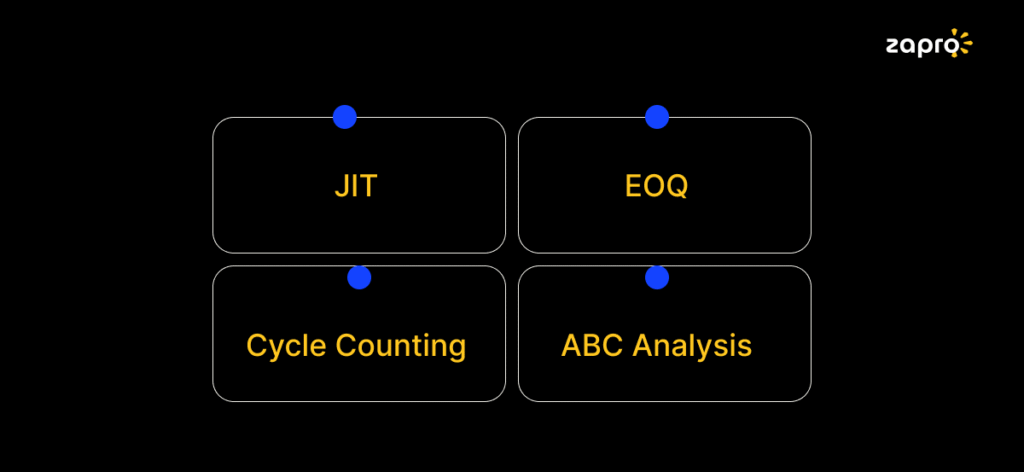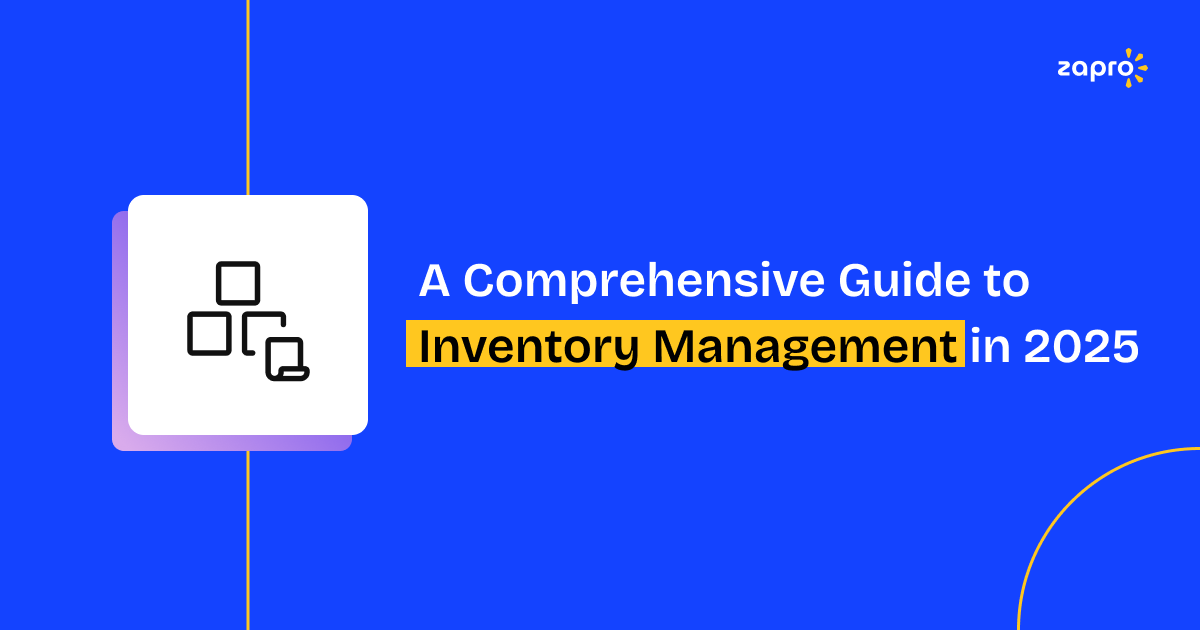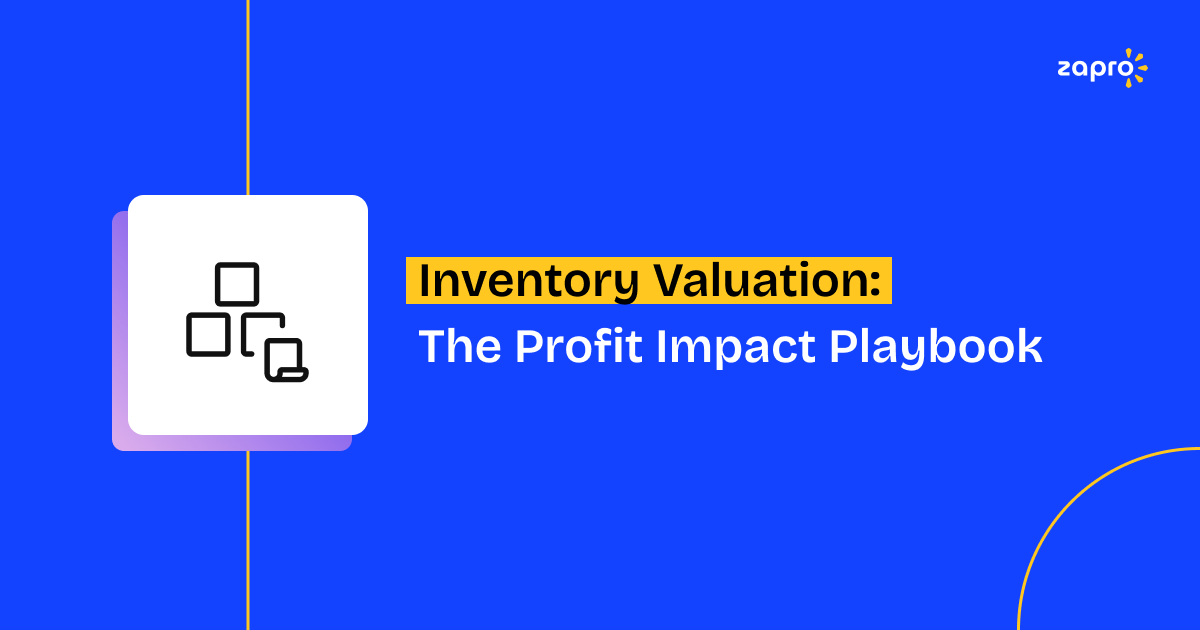All organizations that vend with tangible goods, effective inventory management is crucial. By effectively managing the inventory, they can choose to boost productivity, reduce expenses, and enhance customer satisfaction. While managing the inventory, a lot of things need to be considered widely; in simple terms, it is essential to pick the right inventory levels to put in place a system for tracking inventory.
In this comprehensive guide, we bring to you everything that you need to know about inventory management, ranging from best practices, challenges, and effective solutions. It doesn’t matter if your organization is big or small, because this guide will provide you with the needed information to manage your inventory and increase your bottom line efficiently.
What Is Inventory Management?
Monitoring, governing, and keeping track of the movement of products in and out of your company is called Inventory Management. The entire process entails watching over every move from the buying of goods from suppliers to storing, selling, and delivering them.
Besides these, inventory management also covers the ones that are required to run the daily operations smoothly, such as hardware, stationery, and software. Effective inventory management ensures that the organization has the right amount of inventory at the right time. This way, it helps minimize the expenses related to excess inventory or stockout.
Example of Inventory Management
The best example for inventory management software is the simple retail establishment that takes the help of an inventory management system to stay updated on its stock levels. Through bar code scanning, the retail establishment keeps up-to-date with its inventory. This can also provide a forecast of dropping inventory levels that move the store towards a threshold.
To ensure that the store is stocked right all through the year, the store manager can reorder more goods when inventory drops below a set threshold to satisfy consumer demands. Yet another compelling example is the brewery where inventory management software can play a pivotal role in efficiently managing kegs, bottles, cans, and all other packaging materials. Purchase tracking and optimizing brewery inventory in real-time helps manage the demand and supply of stock in the production house. This eliminates the need for overstocking or tense situations of stockouts.
How Does Inventory Management Work?
Simply put, it involves tracking, managing, and delivering the products. Effective inventory management empowers businesses to effectively and efficiently manage their inventory, guaranteeing that they have the right amount of inventory at the right time to meet the demands.
Inventory Management Process
Numerous stages and coordinations come into play to orchestrate efficient inventory management throughout the year. The process comes with the following steps:
1. Demand Forecasting
The first stage of inventory management is predicting the demand. Using the history of purchasing activities and the present, the trends of purchasing can be decoded. This will help calculate what inventory at what time of the year is required to run smoothly. By carefully understanding the demand patterns, overstocking or stockouts can be ruled out forever and for good.
2. Establishing Reorder Points
The data also comes in handy to suggest the minimum stock levels that need to be maintained to meet customer demands. This is called the reorder point. Establishing a reorder point guarantees timely inventory replenishment, which helps avoid stockouts.
3. Inventory Tracking
Using the RFID, barcoding, or other tracking techniques,
effortlessly know the real-time stock levels. Businesses need to know the right numbers to maintain the right inventory. Where there is clarity on the stock numbers, it is easy to place new orders.
4. Reorder and Restocking
Reordering happens when the stock numbers go down. This is when the orders are placed to restock the inventories. Usually, reordering happens with the same suppliers. When orders are placed, delivery or pickup arrangements must be made. By effectively maintaining contact with the suppliers, the inventory refill happens, avoiding unnecessary hassles.
5. Quality Control
A good quality control process in place helps sourcing and approving the right stock before it is put inside the storage vaults. The quality check inspections ensure the sourced goods satisfy the customer’s requirements without any fear of damage or defect.
6. Storage of Inventory
After the quality check and receipt, the inventory is put away in the assigned location. A wise move would be to plan storage in inventory that is accessible according to the needs. This helps to keep it arranged and minimize the damage to stored items.
Though this may be the last phase of the inventory management process, Inventory analysis helps with insights into statistics and reports. It would also provide insights on Category reports, Inventory availability by location reports, and more to help companies pinpoint areas where inventory management can be strengthened. This approach helps do away with the wastage and improve quality sourcing for the inventory.

According to a report by Gartner, companies that adopt AI-powered inventory management solutions can expect to see an average reduction of 10–15 % in inventory costs and a 15–20 % improvement in service levels.
– Gartner
How do you choose the right inventory management system?
Your business operations will experience significant improvement through the selection of an appropriate inventory management system.
A suitable inventory management system choice helps you achieve your business targets while minimizing expenses and providing complete visibility into your supply chain operations.
A structured approach exists to discover the most suitable inventory management system.
1. Identify your business needs
Begin by determining which inventory management solution features you require including real-time tracking and barcode scanning and multi-location management and procurement and finance system integration.
Your ability to make an excellent decision will improve when you understand your exact requirements.
2. Evaluate key features and integrations
The essential features of an inventory management system should include automated stock updates and reporting dashboards and reorder alerts and demand forecasting capabilities.
The integration of your inventory management system with ERP and POS and cloud-based platforms should provide uninterrupted data exchange between different departments.
3. Assess the system’s ability to scale and its customization options
Your business needs an inventory management system which will expand capabilities as your operations grow.
Your inventory management software needs to handle business expansion through new markets and warehouse additions without causing operational disruptions or adding complicated features.
4. Assess ease of use and user support
The value of an advanced system depends on how well your team members can operate it.
A platform with user-friendly design and easy setup and quick customer assistance will help you reduce system downtime and training duration.
5. Compare pricing and ROI potential
The evaluation process should include both initial expenses and future financial benefits.
The initial investment in automation and analytics systems will generate higher returns because they reduce operational time and minimize errors while optimizing stock levels which results in improved ROI.
6. Check vendor reputation and reviews
Research the reliability of vendors before making any purchase decision.
Review the company’s case studies and read reviews from clients and check their ratings within the industry.
Inventory management solution vendors who have established themselves in the market provide better support and maintain more reliable feature updates.
7. Test with a free trial or demo
The final step before making a purchase requires you to conduct a test.
A trial or live demo allows you to evaluate system performance and usability and integration quality in actual business operations to confirm the software matches your organizational requirements.
What Are the Different Types of Inventory Management?
By choosing the right type of inventory management system, businesses can optimize their inventory levels, eliminate waste, and boost profitability. Everything relies on the system that would meet the specific requirements and objectives of the business.
Businesses can track and manage their inventory using various inventory management systems. These include:
1. Perpetual Inventory System: This system tracks inventory in real-time, providing up-to-date information on stock levels.
2. Periodic Inventory System: This method involves tracking inventory at specific intervals or periods.
3. Manual Inventory System: This is a traditional approach that relies on pen-and-paper for tracking inventory.
These are the most common types of inventory management systems used by businesses.

1. Just In Time (JIT)
JIT inventory management is a system where inventory is delivered to the company as needed, rather than being stored on-site. This method helps reduce waste and optimize inventory levels, but it requires careful cooperation with suppliers.
For instance, rather than ordering large quantities of supplies and storing them on-site, a retail store that employs Just-In-Time (JIT) inventory management would only order enough perishable items to meet anticipated demand. This approach ensures that perishable goods are sold before they expire, helping to minimize waste.
2. Economic Order Quantity (EOQ)
EOQ (Economic Order Quantity) inventory management helps companies determine the optimal amount of inventory to order by continuously monitoring inventory levels. This approach considers various factors such as demand, ordering costs, and carrying costs. By implementing EOQ, businesses can minimize the expenses associated with holding excess inventory and the costs incurred from frequent reordering.
For instance, companies can utilize EOQ to ensure that their IT supplies are kept at optimal levels, effectively reducing expenses. This strategy helps guarantee that they always have sufficient inventory on hand to meet customer demand.
EOQ Formula
Using the Economic Order Quantity (EOQ) model, you can determine the optimal amount of inventory to keep on hand to prevent stockouts and minimize storage costs. The EOQ is calculated using the following formula:
EOQ = √(2DS/H)
In this formula, D represents the annual demand, S is the ordering cost, and H is the carrying cost of the inventory.
3. ABC Analysis
ABC analysis is a method for ranking inventory items based on their importance to the company. This approach emphasizes high-value products over low-value ones, allowing organizations to allocate their resources more effectively.
For instance, a hardware store using ABC analysis would prioritize high-value items like power tools and major hardware over low-value items such as screws and nails. To ensure that these high-value items are always in stock and readily available to customers, the store would invest more resources in managing them effectively.
4. Cycle Counting
Cycle counting is a process that involves counting inventory in smaller, periodic batches rather than conducting a complete inventory count all at once. This approach helps companies detect and correct inventory discrepancies in real time, which enhances inventory accuracy and reduces the likelihood of stockouts or overstocking.
Instead of performing a full inventory count at one time, companies that implement cycle counting inventory management regularly count a percentage of their inventory each day or each week. This method helps identify and resolve inventory discrepancies promptly, further minimizing the chances of stockouts or overstocking.
Why Is Inventory Management Important?
The importance of inventory management for any company is undeniable. Effective inventory management can benefit your business in several ways, including preventing spoilage, reducing dead stock, and minimizing excessive storage costs. Additionally, it can enhance cash flow and maximize customer satisfaction. Here’s how:
1. Decrease Costs
Inventory management helps organizations minimize the costs associated with maintaining and keeping goods.
By optimizing inventory levels, businesses can save big on storage costs, labor costs, and other expenditures.
2. Prevent Spoilage
Deadstock can be expensive for your business as it occupies valuable storage space without yielding any profit. Implementing a careful inventory management plan will help you keep an eye on sales trends, adjust inventory levels to avoid dead stock, remain competitive, and reduce costs.
3. Manage Risk
Inventory management helps firms mitigate risk by identifying potential shortages or surpluses. By anticipating demand and adjusting inventory levels accordingly, businesses can decrease the likelihood of stockouts and overstocking, thus minimizing the financial impact of inventory issues.
4. Improve Cash Flow
Optimizing inventory levels and reducing holding costs enables businesses to free up capital for reinvestment in other areas. Additionally, efficient inventory management leads to shorter storage times, which can increase sales and improve cash flow.
Moreover, effective inventory management helps prevent stockouts, which can result in lost sales and decreased revenue. By maintaining the right amount of inventory to meet customer demand, businesses can avoid missing out on potential sales opportunities.
5. Increase Customer Satisfaction
Effective inventory management enhances order fulfillment. To ensure products are close to your customers, consider implementing strategies like inventory distribution and a seamless return process. This involves maintaining inventory across multiple fulfillment centers, which shortens delivery times and reduces shipping costs. These improvements contribute to customer satisfaction and help you meet your order commitments.
Inventory Management Challenges
A variety of potential challenges can rise when organizations want to effectively manage inventories. A few of the notable inventory management challenges include shifting demand, supply chain concerns, phantom inventory, and unorganized stockrooms. Learn how it affects the organization below:
1. Changing Demands and Customer Preferences
Market trends are subject to change, and thereby, demand for products may rise or fall with a change in consumer preferences. As a result, businesses need to comprehend the demand precisely and maintain the inventory levels. A wrong calculation of a rising demand may lead to excessive buying of unwanted inventory, which occupies a large space and locks up funds for a long time.
2. Phantom Inventory
Items that are in stock but missing or misplaced are termed Phantom Inventory. Reasons could be anything ranging from theft, misplacement, or faults in the inventory management. Phantom inventory can be quite challenging since it can show incorrect inventory levels and stockouts. Phantom inventory is related to affected sales and revenue.
3. Counting Processes
Corporations face dead ends trying to handle complicated counting processes. Manually counting inventory can be prone to errors and take up a lot of time. This can lead to higher labor costs and difficulties in meeting deadlines due to discrepancies in inventory levels. As a result, the inventory management system may become inaccurate, which can ultimately impact sales and revenue.
4. Disorganized Storerooms
When stockrooms are unorganized, businesses find it problematic to manage inventory adequately. It might be difficult to locate and organize products if inventory is not stowed in a systematic and effective way. This can cause errors in the inventory management system, making it difficult to effectively monitor inventory levels.
5. Supply Chain Disruptions
A supply chain interruption can lead to the unavailability of inventory for a company, resulting in stockouts or delays in processing customer orders. This will affect sales of the company and harm its reputation. Additionally, a supply chain disruption can make it difficult for firms to efficiently manage their inventory and plan for future demand by causing uncertainty about inventory levels.
The future of inventory management
Business operations continue to transform which leads to new approaches for inventory management. The upcoming era of inventory management will be powered by technological advancements and sustainable practices and data-driven decision systems. Modern inventory management practices will experience transformation through several key developments during the upcoming decade.
- AI in inventory optimization
Artificial intelligence systems now enable businesses to optimize their demand forecasting and stock management operations.
AI-based inventory management systems analyze current sales data and seasonal patterns and market information to generate accurate product demand forecasts for specific locations.
The system helps businesses achieve optimal stock levels through precise demand forecasting which prevents both stockouts and overstocking situations. - Automation and smart warehousing
Modern warehouses have evolved into connected facilities that use advanced technology systems.
The combination of automated picking systems with IoT sensors and robotic technology performs repetitive work while eliminating human mistakes.
The combination of cloud-based inventory management with these technologies enables businesses to monitor their stock levels and track movements and performance data between different locations in real time. - 3D printing enables businesses to produce items on demand through on-demand manufacturing
The production and storage of inventory undergoes transformation through the implementation of 3D printing technology.
Companies can pretty much use on-demand printing to create parts and products which will finally eliminate the need for holding large stockpiles and reduce storage expenses. - Reverse Logistics and Sustainable Inventory Practices
The core operation of contemporary inventory management systems depends on sustainability principles. The reverse logistics system helps businesses handle returns and recycling and refurbishment operations which extend product life through reuse instead of waste disposal.
The circular business model enables organizations to reduce their environmental impact while building customer loyalty and achieving sustainable cost reductions.
Inventory management technologies
Businesses use modern inventory management technologies to achieve fast and accurate operations through intelligent systems that handle stock management. The new technologies simplify intricate operations while reducing mistakes to maintain flexible and efficient supply chain operations.
- AI-powered inventory forecasting
The implementation of artificial intelligence technology enables businesses to make highly accurate predictions about future market requirements. AI-based inventory management solutions use historical sales data and market patterns and seasonal variations to help teams forecast stock requirements which results in better warehouse space utilization and reduced waste. - Automated reordering and workflow management
The system prevents stock shortages because it operates automatically.
Cloud-based inventory management systems provide automated reorder points and purchase approvals and workflow triggers which enable businesses to operate continuously without human involvement. - Real-time inventory tracking and analytics dashboard
The ability to track inventory movements in real time provides teams with immediate access to stock status and order progress and delivery precision. The system presents all available data through dashboards which help teams make quick decisions while controlling their daily operations. - Seamless integration with procurement and supply chain systems
An optimal inventory management system operates as a single unit with procurement and finance and logistics tools through complete integration. The system connects all departments from purchase requisition to delivery through its integrated data management system which prevents information silos. - Data-driven insights for smarter decision-making
The combination of advanced reporting and analytics transforms unorganized data into meaningful business intelligence. The ability to track KPIs and analyze trends and forecast needs enables businesses to make strategic inventory decisions which boost profitability and operational efficiency.
Key takeaways
- Optimizing stock levels, decreasing the costs and maintaining supply chain efficiency depend on proper inventory management.
- A suitable inventory management system enables automated operations with AI forecasting and real-time tracking to enhance both precision and system control.
- Cloud-based inventory management systems deliver flexible growth capabilities and instant access to data and effortless team collaboration.
- The integration of inventory management solutions with procurement and finance systems creates better visibility and maintains consistent data across all systems.
- The supply chain industry is evolving through the combination of AI technology with smart warehouse systems and environmentally friendly inventory management methods which will create the next generation of efficient technology-based supply chains.
Handle Your Inventory Using Zapro.ai Platform
Zapro.ai provides the complete solution for managing your inventory, procurement, and supply chain activities. It offers an all-in-one solution for all of your inventory management requirements, including demand forecasting, order fulfillment, and reporting. Its low-code platform is very much user-friendly, which automates workflows and supports real-time data tracking. With this, it would be easy for you to manage and control the inventory and streamline your business processes with ease.
A compelling inventory management system like Zapro.ai would easily influence your company to help you attain success for a very long time. Book a free demo of Zapro.ai and take control of your inventories.
Get started with Zapro.ai and learn how to leverage its features to drive better results.
Conclusion
The practice of inventory management requires more than basic stock tracking because it enables businesses to create better plans and operate with efficiency and speed in their responses. The implementation of an appropriate system enables organizations to remove operational waste while enhancing their forecasting abilities and financial performance.
Zapro provides businesses with a single platform that combines automation with analytics and real-time visibility through its modern inventory management solution. The platform will also enable your teams to take proactive decisions with the help of real-time data analysis which transforms inventory management into a strategic business advantage for organizations that are operating across multiple warehouses and locations across the world.
Smarter, future-ready inventory management with Zapro.ai.

Frequently asked questions
1. What are the objectives of inventory management?
The main goals of inventory management include achieving proper stock levels and cost reduction and product availability while avoiding both stockouts and overstocking.
2. How can inventory management be improved?
Businesses need to improve their inventory management through cloud-based systems and automated reordering and KPI tracking and complete procurement workflow integration for achieving full supply chain visibility.
3. What industries benefit the most from inventory management software?
The most profitable sectors for inventory management software adoption include retail and manufacturing as well as healthcare and logistics and e-commerce. The mentioned business sectors require efficient inventory management systems to control their expenses and fulfill their delivery obligations.
4. What features should businesses look for in an inventory management platform?
Businesses need to choose inventory management platforms which integrate AI-based forecasting with real-time tracking and automated workflows and multi-location management and procurement and finance and ERP system connections.
5. How can Zapro.ai enhance inventory visibility and control?
The inventory data of Zapro.ai exists in a single cloud-based inventory management system. The system enables real-time monitoring and automated warning systems and sophisticated analytical tools which provide teams with full oversight of inventory quantities and market trends and warehouse operational performance.
Don’t miss our weekly updates
We’ll email you 1-3 times per week—and never share your information.

 Healthcare
Healthcare Financial Services
Financial Services Technology
Technology Venture Capitalist
Venture Capitalist Chief Procurement Officer
Chief Procurement Officer Chief Financial Officer
Chief Financial Officer




